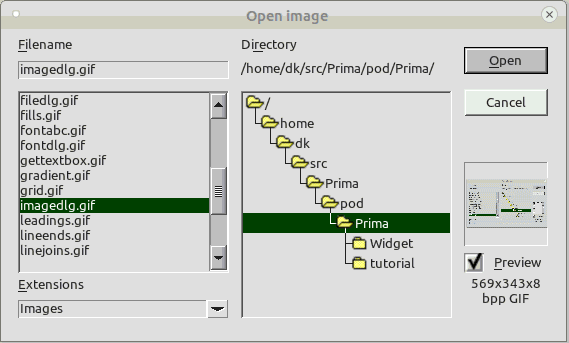NAME
Prima::Dialog::ImageDialog - image file open and save dialogs
DESCRIPTION
The module provides standard dialogs specially adjusted for image loading and saving.
Prima::Dialog::ImageOpenDialog
Provides a preview widget, allowing the user to view the image file before loading, and the selection of a frame index for the multi-framed image files. Instead of the execute call, the load method is used to invoke the dialog and returns the loaded image as a Prima::Image object. The loaded object contains the {extras} hash with the file and image information filled by the loader. See Prima::image-load for more information.
SYNOPSIS
use Prima qw(Application Dialog::ImageDialog);
my $dlg = Prima::Dialog::ImageOpenDialog-> new;
my $img = $dlg-> load;
return unless $img;
print "$_:$img->{extras}->{$_}\n" for sort keys %{$img-> {extras}};
Properties
- preview BOOLEAN
-
Selects if the preview functionality is active. The user can switch it on and off interactively.
Default value: 1
Methods
- load %PROFILE
-
Executes the dialog, and, if successful, loads the image file and frame selected by the user. Returns the loaded image as a
Prima::Imageobject. PROFILE is a hash, passed to thePrima::Image::loadmethod. In particular, it can be used to disable the default loading of extra information in the{extras}hash variable or to specify a non-default loading option. For example,{extras}->{className} = 'Prima::Icon'would return the loaded image as an icon object. See Prima::image-load for more.loadcan report the progress of the image loading to the caller, and/or to an instance ofPrima::ImageViewer, if desired. If either (or both)onHeaderReadyandonDataReadynotifications are specified, these are called from the respective event handlers of the image being loaded ( see "Loading with progress indicator" in Prima::image-load for details). If the profile keyprogressVieweris supplied, its value is treated as aPrima::ImageViewerinstance, and it is used to display the loading progress. See "watch_load_progress" in Prima::ImageViewer.
Events
Prima::Dialog::ImageSaveDialog
Provides the standard image save dialog where the user can select the desired image format, the bit depth, and other format-specific options. The format-specific options can be set if a dialog for the file format is provided by the toolkit. The standard toolkit dialogs reside under the Prima::Image namespace, in the Prima/Image subdirectory. For example, Prima::Image::gif provides the selection of a transparent color, and Prima::Image::jpeg provides the image quality control. If the image passed to the image property contains the {extras} hash variable, its data are used as the default values. In particular, the {extras}->{codecID} field, responsible for the file format, affects the default file format selection.
SYNOPSIS
my $dlg = Prima::Dialog::ImageSaveDialog-> new;
return unless $dlg-> save( $image );
print "saved as ", $dlg-> fileName, "\n";Properties
- image IMAGE
-
Selects the image to be saved. The property is to be used for the standard invocation of dialog, via the
executemethod. It is not needed when the execution and saving are invoked via the save method.
Methods
- save IMAGE, %PROFILE
-
Invokes the dialog, and, if the execution is successful, saves the IMAGE according to the user selection and PROFILE hash. PROFILE is not used as a source of the default options, but is passed directly to the
Prima::Image::savecall, possibly overriding the selection of the user.Returns 1 on success, 0 on error. If the error occurs, the user is notified before the method returns.
AUTHOR
Dmitry Karasik, <dmitry@karasik.eu.org>.
SEE ALSO
Prima, Prima::Window, Prima::codecs, Prima::image-load, Prima::Image, Prima::Dialog::FileDialog, Prima::ImageViewer, examples/iv.pl.